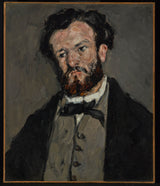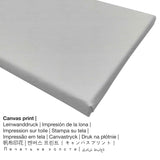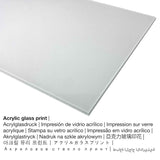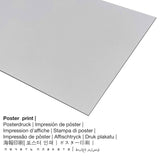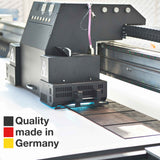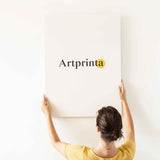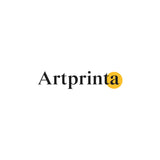Paul Cézanne, 1871 - Eserese Anthony Valabrègue - mbipụta nka mara mma
Ụtụ gụnyere. Mbupu gbakọrọ na ndenye ọpụpụ.
Nkọwa ndị ọzọ site na ihe ngosi nka (© Nwebiisinka - Ụlọ ihe ngosi nka J. Paul Getty - Ụlọ ihe ngosi nka nke J. Paul Getty)
When a jury member at the Paris Salon of 1866 first saw Paul Cézanne's portrait of the journalist and critic Antony Valabrègue, he exclaimed that the portrait was not painted with a knife but with a pistol. Although the Salon refused him admission, Cézanne continued to paint many portraits of his friend, including the present example, thought to have been painted around 1869 to 1871.
For this painting, Cézanne used a palette knife rather than brushes. With the spatula-like instrument, he applied paint in thick, successive layers, giving the surface a complex, rough-and-smooth texture. He then used the knife to squeeze the paints together so that they mixed directly on the canvas. In this fashion Cézanne moved the paint around, eliminating contour lines and instead creating impastoed areas of color, as if sculpting in paint. In another portrait of his friend made four years earlier, the coarse, almost violent appearance created by Cézanne's technique led Valabrègue to complain in a letter to the writer Zola: "He has given me such a fierce complexion that it reminds me of the statue of Champfleury when it was stained with squashed blackberries."
Nkọwa nke ihe nka ihe karịrị afọ 140
a 19th narị afọ masterpiece was painted by Paul Cézanne. Besides, this piece of art is included in the Ụlọ ihe ngosi nka nke J. Paul Getty collection in Los Angeles, California, United States of America. We are pleased to state that this ngalaba ọha artpiece na-ọnọ n'ikike nke Ụlọ ihe ngosi nka nke J. Paul Getty.Ebe E Si Nweta nke ihe osise:. Ọzọkwa, alignment bụ Eserese ma nwee oke nke 1: 1.2, nke pụtara na ogologo bụ 20% mkpụmkpụ karịa obosara. Paul Cézanne was a male painter from France, whose style was primarily Impressionism. The European artist was born in 1839 na nwụrụ anwụ na afọ nke 67 Na 1906 na Aix-en-Provence.
Kedu ihe ebipụta m nwere ike ịhọrọ?
We offer a range of various materials and sizes for every product. Pick your favorite size and material between the following alternatives:
- Bipụta na enyo acrylic: An acrylic glass print, often referenced as a an art print on plexiglass, will convert your favorite original artwork into brilliant wall decoration. In addition to that, the acrylic glass art print is a viable alternative to aluminium or canvas art prints. The artwork will be made with state-of-the-art UV print machines. With an acrylic glass fine art print contrasts and details will be more identifiable thanks to the very subtle gradation.
- Mbipụta kwaaji: A canvas print, not to be mistaken with a real painting on a canvas, is an image printed on an industrial printing machine. Further, a printed canvas generates a familiar and pleasant impression. Canvas prints are relatively low in weight, meaning that it is easy and straightforward to hang up your Canvas print without the help of extra wall-mounts. Therefore, a canvas print is suited for any type of wall in your home.
- Ebipụta akwụkwọ mmado na ihe akwa akwa: Our poster is a UV printed sheet of canvas with a nice surface texture, which resembles the actual version of the work of art. It is particularly qualified for framing the art copy in a special frame. Please bear in mind, that depending on the size of the poster we add a white margin of around 2-6cm round about the print, which facilitates the framing with your custom frame.
- Aluminom dibond mbipụta (ọla): These are metal prints on aluminium dibond with a true depth. A direct Aluminium Dibond Print is your ideal introduction to fine art prints on aluminum. Colors are vivid and luminous, details appear clear and crisp.
Banyere omenka
| aha: | Paul Cézanne |
| okike nke onye nka: | nwoke |
| Obodo onye nka: | French |
| Ọrụ nke onye na-ese ihe: | onye na-ese ihe |
| Mba onye si: | France |
| Nhazi nke onye nka: | omenkà nke oge a |
| styles: | Mmetụta |
| Ndụ: | 67 afọ |
| Afọ ọmụmụ: | 1839 |
| Afọ nwụrụ: | 1906 |
| Nwụrụ na (ebe): | Aix na Provence |
Nkọwa ọrụ nka
| Aha ọrụ nka: | "Portrait of Anthony Valabrègue" |
| Nchịkọta nke ọrụ nka: | sere |
| Okwu mkpokọta: | nkà nke oge a |
| oge: | 19th narị afọ |
| Afọ okike: | 1871 |
| Ogologo afọ nka nka: | ihe dị ka afọ 140 |
| Ụlọ ihe ngosi nka / mkpokọta: | Ụlọ ihe ngosi nka nke J. Paul Getty |
| Ebe ngosi nka: | Los Angeles, California, Njikota Obodo Amerika |
| Weebụsaịtị nke ihe ngosi nka: | www.getty.edu |
| License: | ngalaba ọha |
| Site n'aka: | Ụlọ ihe ngosi nka nke J. Paul Getty |
Ozi ederede
| Nkewa ngwaahịa: | ezi nka mmeputakwa |
| Usoro mmeputakwa: | dijitalụ mmeputakwa |
| Production usoro: | UV kpọmkwem obibi |
| Mmalite nke ngwaahịa a: | German mere |
| Stockdị ngwaahịa: | na mmepụta ihe |
| Ngwaahịa were: | mgbidi mgbidi, ihe ndozi ụlọ |
| Nhazi: | usoro eserese |
| Oke akụkụ: | 1: 1.2 - ogologo: obosara |
| Ihe: | ogologo bụ 20% mkpụmkpụ karịa obosara |
| Akwa mmeputakwa dị: | Mpempe iko acrylic (nke nwere ezigbo mkpuchi iko), mbipụta ọla (aluminium dibond), mbipụta akwụkwọ mmado (akwụkwọ kwaaji), mbipụta kwaaji. |
| Mpempe akwa akwa (akwa akwa na etiti ihe ndọtị) nha: | 50x60cm - 20x24", 100x120cm - 39x47", 150x180cm - 59x71" |
| Mbipụta iko acrylic (nwere ezigbo mkpuchi iko) dị iche iche: | 50x60cm - 20x24", 100x120cm - 39x47", 150x180cm - 59x71" |
| Mpempe akwụkwọ mmado (akwụkwọ kwaaji) nha: | 50x60cm - 20x24", 100x120cm - 39x47" |
| Nhọrọ nha nke mbipụta aluminom (aluminium dibond material) | 50x60cm - 20x24", 100x120cm - 39x47" |
| ụba: | agunyeghi |
Nkwupụta iwu: We try in order to depict our products as closely as possible and to illustrate them visually in our shop. Still, the colors of the printed materials, as well as the printing might differ marginally from the image on your device's screen. Depending on your settings of your screen and the quality of the surface, color pigments can unfortunately not be printed 100% realistically. Because the are printed and processed by hand, there may as well be slight variations in the motif's size and exact position.
© nwebisiinka, Artprinta.com

